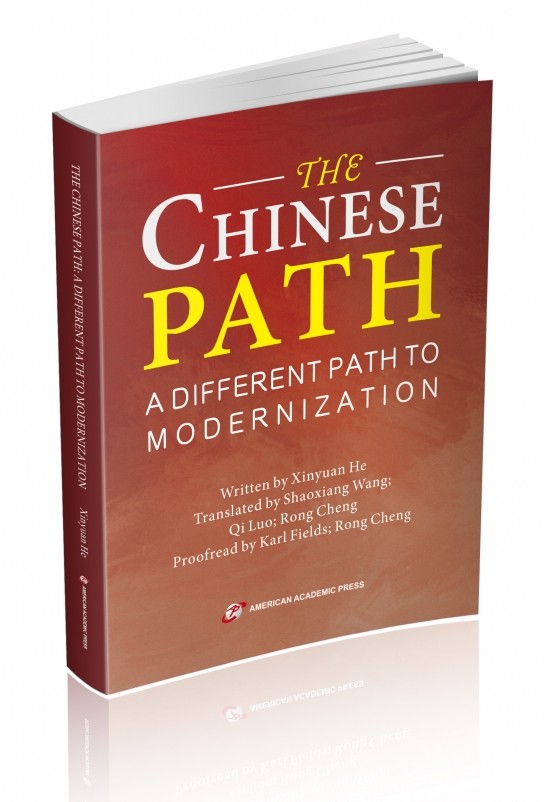
 Qzone
Qzone
 微博
微博
 微信
微信
据全国哲学社会科学工作办公室和福建师范大学消息(记者金哲骏),日前,中国国家社科基金中华学术外译项目《中国道路:不一样的现代化道路》英文版THE CHINESE PATH:A DIFFERENT PATH TO MODERNIZATION由国际权威出版社美国学术出版社公开出版发行。

国家社科项目《中国道路》在美国学术出版社隆重出版
美国学术出版社出版的《中国道路:不一样的现代化道路》揭示“中国道路”整体演化的系统性与必然性。在历史纵向发展中(从时间维度)认识“中国道路”强大而内在的生命力,在国际横向比较中(从空间维度)认识“中国道路”演化的艰巨性与优越性,进而获知“中国道路”内在的社会主义价值取向,以展示“中国道路”是一条与西方现代化道路完全不一样的现代化道路进而坚定对中国特色社会主义道路的自觉和自信,同时在国际上促进各国对“中国道路”,特别是对中国特色社会主义道路的理解和认同。
“中国道路” 可以表述为中国社会的一次艰难而伟大的转型,即从一个农业社会转变为一个工业社会,从一个封闭社会转变为一个开放社会,从一个传统文明社会(前现代)转变为一个现代文明社会。这一转型自晚清始(确切讲是1840年)就已经开始,到现在已跨世纪而历经170多年。到今天,它依然还是一个未彻底完成的方案,依然还是一种 “进行时态” 。站在十八大开启的新的历史起点上重谈 “中国道路” 这一老问题,是想按照人类社会发展规律有序地推进这一进程,以进一步对中国特色社会主义道路的历史必然性进行理性而深刻的思考,因为这关乎着中华民族伟大复兴中国梦的实现,这也是对学者历史责任感的一种强烈呼唤与思想拷问。
本书作者贺新元教授现任中国社会科学院马克思主义研究院中国特色社会主义理论体系研究室主任,副研究员,法学博士。译者王绍祥副教授为福建师范大学国际处处长、党支部书记。
英文版《中国道路:不一样的现代化道路》是美国学术出版社继出版中国国家社科基金中华学术外译项目《中国文化通论》、《发生与诠释:儒学形成、发展之主体向度的追寻》,《中国阿尔泰语系诸民族神话比较研究》,《瓷之纹》 ,《瓷之色》,《中国粮食安全与农业走出去战略研究》,《全球视野下的中国道路》,《诗人翻译家穆旦(查良铮)评传》,《聚焦钓鱼岛-钓鱼岛主权归属及争端解决》,《中国方言与文化》、《中国传统译论经典诠释——从道安到傅雷》,《经济增长与结构演进:中国新时期以来的经验》,《中国绘画思想史》,《匈奴通史》,《明代书坊与小说研究》,《当代荷马《玛纳斯》演唱大师居素普·玛玛依评传》,《从庄子到郭象——《庄子》与《庄子注》比较研究》,《孙中山传》及教育部人文社会科学研究规划基金项目《中国经典古诗词精选100首英译》,Multimodal Discourse Information Processing in English Classroom Instruction for Legal Purposes,经典中国国际出版工程《郁达夫旧诗英译》、《中国古代乐舞史》等多部作品后的又一部力作。该书出版后,在北美公开发行,谷歌,亚马逊等主流媒体均有销售。多年来,美国学术出版社一直是中国国家社会科学基金中华学术外译项目中推荐的国际权威出版社。
中华学术外译项目是国家社科基金项目的主要类别之一。该项目通过资助我国哲学社会科学研究的优秀成果以外文形式在国外权威出版机构出版,促进中外学术交流,推动我国哲学社会科学优秀成果和优秀人才走向世界。
附:英文版《中国道路:不一样的现代化道路》目录
THE CHINESE PATH:A DIFFERENT PATH TO MODERNIZATION
Preface
Introduction
0.1 “Path” (Daolu) – The Dialectical Unity of Abstraction and Concreteness
0.2 The Chinese Path: The Dialectical Unity of Historical and Logical Points of Origin
0.3 The Chinese Path Marks the Transformation of Chinese Civilization
0.4 A Path of Socialism with Chinese Characteristics Is of Vital Importance for China’s Future
0.5 Main Points and Structure of the Book
Part I: Historical Evolution of the Chinese Path
Chapter One The Chinese Path Born from Trial and Error (1840-1921)
1.1 Historical Context and Task
1.2 Birth of the Chinese Path
Chapter Two Against All Odds, the Chinese Path Came into Being through Revolution (1921-1956)
2.1 Lenin’s Evaluation of Sun Yat-sen and His Three People’s Principles
2.2 The New Culture Movement and the Dissemination of Marxism-Leninism in China
2.3 The May 4th Movement of 1919 Triggered the New Democratic Revolution and Became a Watershed between the New and the Old
2.4 The First KMT-CPC Cooperation: A Doomed-to-Fail Temporary Alliance in which the KMT Held the Advantage over the CPC and Both Parties Cooperated for Their Own Interests
2.5 Agrarian Revolution and the Revolutionary Path in Jinggang Mountains
2.6 Mao Zedong Thought and Victory of the War of Resistance against Japanese Aggression
2.7 Agrarian Reform and Socialist Transformation
Chapter Three The Chinese Path: Socialist Development amid Twists and Turns (1956-1976)
3.1 To Blaze Our Own Path to Socialist Development
3.2 Brief Analysis of the Causes and Lessons Learned from Errors in the Twenty-Year Exploration of the Path to Socialist Development and Its Implications
Chapter Four The Chinese Path Developed and Improved in Reform (1976 - )
4.1 Deng Xiaoping Theory and the Blazing of the Path of Socialism with Chinese Characteristics
4.2 The Theory of Three Represents and the Development of the Path of Socialism with Chinese Characteristics
4.3 The Scientific Outlook on Development and Promoting the Path of Socialism with Chinese Characteristics
4.4 Guiding Principles from General Secretary Xi Jinping’s Major Policy Addresses and the New Vistas for the Path of Socialism with Chinese Characteristics
Chapter Five Developing and Improving the Systems for the Chinese Path
5.1 A Sketch of the Development of the Fundamental Political System
5.2 A Chronological Account of the Basic System
5.3 An Overview of Concrete Systems
Chapter Six Summary: The Transformation and Rebirth of the Chinese Nation along the Chinese Path
Part II: Interpretations of the Chinese Path
Chapter Seven The Chinese Path Is Different from the Soviet Path
7.1 Different Paths to Revolution
7.2 Different Paths to Development
7.3 Different Paths to Reform
7.4 A Brief Methodological Analysis of the Two Perspectives on Reform
Chapter Eight The Chinese Path Is Different from the Capitalist Path
8.1 The Unsustainability and Direction of Development of the Western Capitalist Path to Modernization
8.2 The Trap of Latin American Countries’ Path to Capitalism
8.3 Traditional Chinese Culture: Roots of the Chinese Path
8.4 China’s Context: The Soil of the Chinese Path
Chapter Nine The Rationale of the “Lu” (Road) in the Chinese Path (“Daolu”)
9.1 Dialectic Thinking in the Pioneering of the Chinese Path
9.2 The Dialectical Direction for the Development of the Chinese Path
9.3 Essential Features of the Development of the Path of Socialism with Chinese Characteristics
Chapter Ten The Rationale of the “Dao” (Way) Guiding the Chinese Path (“Daolu”)
10.1 The Universal Truth: The Integration of the Universal Truth of Marxism-Leninism with the Concrete Practice of a Country
10.2 The Ideological and Theoretical Legacy of Mao Zedong in 1956 and Socialism with Chinese Characteristics
10.3 Deng Xiaoping’s Development Philosophy and Socialism with Chinese Characteristics
Chapter Eleven Revisit and Reflect: The Development of the Chinese Path
11.1 The Chinese Path Revisited
11.2 Implications of the Development of the Chinese Path
Chapter Twelve Summary: The Chinese Path Extends Throughout National Rejuvenation
Part III: Contributions of the Chinese Path to Civilization
Chapter Thirteen The Chinese Path: The Transformation and Modernization of Chinese Civilization
13.1 Why Could the Traditional Chinese Civilization Be Transformed
13.2 The Chinese Path: The Choice of Path for the Transformation of Chinese Civilization
13.3 The Path of Socialism with Chinese Characteristics Is the Correct Practice of the Strategy of “Founding the Country on Civilization”
13.4 A Different Modernization Is Possible and Realistic
Chapter Fourteen Global Implications of the Chinese Path
14.1 The Impact of the Chinese Revolution upon the World
14.2 China’s Reform Holds Global Significance for Russia, the US or the UK in Their Reforms
14.3 The Global Significance of the Path of Socialism with Chinese Characteristics
Chapter Fifteen Summary: The World Needs a Culturally Advanced China Featuring Rejuvenation, Inclusiveness and Innovation
Conclusion Improve “Chinese Awareness” with Every Confidence in the Chinese Path
16.1 Confidence in the Chinese Path Derives from History
16.2 Confidence in the Path Derives from Culture
16.3 Confidence in the Chinese Path Derives from Comparison
16.4 Confidence in the Path Allows No Blindness But Requires Alertness to Adversity
Bibliography
Epilogue









